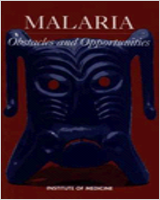NCBI Bookshelf. A service of the National Library of Medicine, National Institutes of Health.
Institute of Medicine (US) Committee for the Study on Malaria Prevention and Control; Oaks SC Jr., Mitchell VS, Pearson GW, et al., editors. Malaria: Obstacles and Opportunities. Washington (DC): National Academies Press (US); 1991.

Malaria: Obstacles and Opportunities.
Show detailsTYPES OF MALARIA
- 1.
African wet savannah
- 2.
Forest
- 3.
Irrigated agriculture
- 4.
Highland fringe
- 5.
Desert fringe and oasis
- 6.
Urban malaria
- 7.
Plains—traditional agriculture
- 8.
Coastal
DETERMINANTS
- 1.
Level of endemicity
- 2.
Parasite species
- * Plasmodium falciparum
- * P. vivax
- * P. malariae
- * P. ovale
- 3.
Population characteristics
- * Immune status (high, low, none)
- * Movement (settled, resettled, transient); if transient: organized, nomads, random
- * Population density and settlement patterns
- 4.
Social, behavioral, and economic characteristics
- * Housing
- * Occupation
- * Water utilization
- * Health-seeking behavior
- * Sleeping habits
- * Customs and taboos
- * Income and wealth
- * Local understanding of malaria
- * Access to health care
- 5.
Health infrastructure
- * National health budget
- * Status of governmental health care delivery system
- * National malaria control program (type, budget, and efficiency)
- * Importance of non-governmental services (i.e. missions, private voluntary organizations)
- * Availability of private health care
- * Importance of health care delivery by family, market, etc.
- 6.
Use of drugs
- * Cost
- * Availability
- * Drug-use patterns
- * Effectiveness (degree of resistance)
- 7.
Vector considerations
- * Behavior (breeding, feeding, resting)
- * Susceptibility to insecticides
- * Cost, safety, and acceptability of effective insecticides
- * Availability and cost of bed nets
- * Feasibility of bed net impregnation with insecticides
- * Availability and cost of repellents and fumigant coils
- 8.
Development projects
- * Government development projects (dam construction, road building)
- * Unofficial or illegal activities (mining, gemming)
- - organized
- - random
TOOLS
- 1.
Vector control
- * Personal protection
- - nets or curtains with or without insecticide
- - screens
- - house siting (where the house is physically located)
- - repellents
- - smoke coils
- * Environmental management
- - source reduction
- - flushing, sluicing
- - clearing vegetation
- - water management
- - reforestation
- * Larvicides
- - chemical
- - mechanical
- - biological
- * Adulticiding (killing the adult forms of the mosquito)
- - residual spraying
- - fogging
- - large-scale ULV (ultra low volume spraying)
- * Zooprophylaxis
- 2.
Medical resources
- * Diagnosis
- - clinical
- - microscopic
- * Treatment facilities
- - inpatient
- - outpatient
- - market
- * Prophylaxis
- * Mass chloroquine-primaquine administration for epidemics
- 3.
Information, education, and communication
- * Public
- - individuals, households, and communities
- - school curricula
- - radio
- - newspapers
- - television
- - local media (songs, theater, etc.)
- * Health care providers
- 4.
Surveillance
- * Diagnosis and treatment
- - morbidity
- - incidence of severe malaria
- - mortality
- - prevalence of parasitemia
- * Epidemic early warning
- * Vector information
- - insecticide resistance
- - behavioral changes
- * Antimalarial drug resistance
- PARADIGMS - MalariaPARADIGMS - Malaria
Your browsing activity is empty.
Activity recording is turned off.
See more...